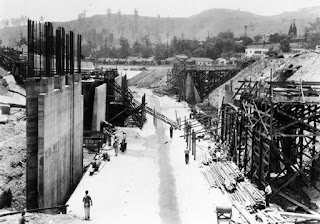Aesthetics deals with beauty, the nature of beauty and how we relate to beauty. Aesthetics raises questions such as ‘does beauty have an intrinsic nature or do we ascribe beauty to an object or scene? Is beauty in the eye of the beholder or are there specific things or arrangements in nature that project beauty? Elsewhere, I have suggested that training and experience in ecology allows for a multidimensional aesthetic of living systems. I’m increasingly convinced that 'holographic' is a more complete description of what an ecologist sees when he or she views a living system.
 The beauty of the vision or perception is not
simply two dimensional and what is obvious to the eyes but at least three dimensional.
Think about this as if you were looking into a round, clear plastic cylinder, perhaps
a cylindrical aquarium stretching floor to ceiling. A crystal tube without
distortion. The cylinder descends into the sand of a lagoon. Your eyes move upward
passing the roots of aquatic vegetation such as rushes then up the stalks
…through the water into the air above the water where a mollusk rests near
the top of one of the stalks. All of this in three dimensions with small fish
darting about and among the stalks..snails crawling along the stalks, small crustaceans
buried in the muck below…
The beauty of the vision or perception is not
simply two dimensional and what is obvious to the eyes but at least three dimensional.
Think about this as if you were looking into a round, clear plastic cylinder, perhaps
a cylindrical aquarium stretching floor to ceiling. A crystal tube without
distortion. The cylinder descends into the sand of a lagoon. Your eyes move upward
passing the roots of aquatic vegetation such as rushes then up the stalks
…through the water into the air above the water where a mollusk rests near
the top of one of the stalks. All of this in three dimensions with small fish
darting about and among the stalks..snails crawling along the stalks, small crustaceans
buried in the muck below… Can I see all of those things at a glance? No. But
I’ve seen this type of system so many times, in freshwater and salt, over the decades of my professional
life that I see them, in my mind’s eye. I am immersed in them. They surround me...envelop me. Ecologists who work in a watery environment, with snorkel and mask or SCUBA, may experience this envelopment more than others. Perhaps learning to look holographically
is a good teaching/learning tool. A holographic appreciation of the beauty of
the site helps develop an aesthetic appreciation that includes an in depth understanding of nature in in depth and in motion. Holographically, one looks into a living system rather than simply onto a two dimensional representation of the system. Beauty is , indeed, more then skin deep.
Can I see all of those things at a glance? No. But
I’ve seen this type of system so many times, in freshwater and salt, over the decades of my professional
life that I see them, in my mind’s eye. I am immersed in them. They surround me...envelop me. Ecologists who work in a watery environment, with snorkel and mask or SCUBA, may experience this envelopment more than others. Perhaps learning to look holographically
is a good teaching/learning tool. A holographic appreciation of the beauty of
the site helps develop an aesthetic appreciation that includes an in depth understanding of nature in in depth and in motion. Holographically, one looks into a living system rather than simply onto a two dimensional representation of the system. Beauty is , indeed, more then skin deep.Note: Several of us have formed an Environmental Aesthetic Study Group. Contact me at springmountain1@att.net in order to join.














